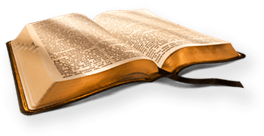King James Bible
King James Version (KJV)


"For grinding corn, mentioned as used in the time of Abraham" (Gen. 18:6). That used by the Hebrews consisted of two circular "stones, each 2 feet in diameter and half a foot thick, the lower" "of which was called the "nether millstone" (Job 41:24) and the" "upper the "rider." The upper stone was turned round by a stick" "fixed in it as a handle. There were then no public mills, and" thus each family required to be provided with a hand-mill. The "corn was ground daily, generally by the women of the house (Isa." "47:1, 2; Matt. 24:41). It was with the upper stone of a" "hand-mill that "a certain woman" at Thebez broke Abimelech's" "skull (Judg. 9:53, "a piece of a millstone;" literally, "a" "millstone rider", i.e., the "runner," the stone which revolves." Comp. 2 Sam. 11:21). Millstones could not be pledged (Deut. "24:6), as they were necessary in every family."
A thousand years; the name given to the era mentioned in Rev. 20:1-7. Some maintain that Christ will personally appear on earth for the purpose of establishing his kingdom at the beginning of this millennium. Those holding this view are "usually called "millenarians." On the other hand, it is" "maintained, more in accordance with the teaching of Scripture," "we think, that Christ's second advent will not be premillennial," and that the right conception of the prospects and destiny of "his kingdom is that which is taught, e.g., in the parables of" "the leaven and the mustard-seed. The triumph of the gospel, it" "is held, must be looked for by the wider and more efficient" operation of the very forces that are now at work in extending the gospel; and that Christ will only come again at the close of "this dispensation to judge the world at the "last day." The" millennium will thus precede his coming.
"(Heb. dohan; only in Ezek. 4:9), a small grain, the produce of" the Panicum miliaceum of botanists. It is universally cultivated in the East as one of the smaller corn-grasses. This seed is the "cenchros of the Greeks. It is called in India warree, and by the" "Arabs dukhan, and is extensively used for food, being often" mixed with other grain. In this country it is only used for feeding birds.
"(Heb. always with the article, "the" Millo). (1.) Probably the" "Canaanite name of some fortification, consisting of walls filled" "in with earth and stones, which protected Jerusalem on the north" "as its outermost defence. It is always rendered Akra i.e., "the" "citadel", in the LXX. It was already existing when David" conquered Jerusalem (2 Sam. 5:9). He extended it to the right "and left, thus completing the defence of the city. It was" "rebuilt by Solomon (1 Kings 9:15, 24; 11:27) and repaired by" Hezekiah (2 Chr. 32:5). "(2.) In Judg. 9:6, 20 it is the name of a rampart in Shechem, "probably the "tower of Shechem" (9:46, 49)."